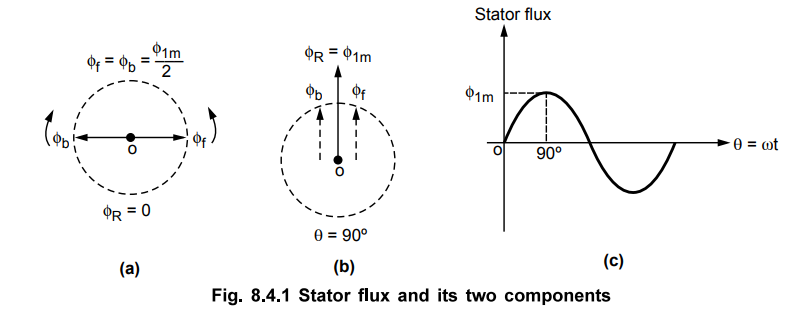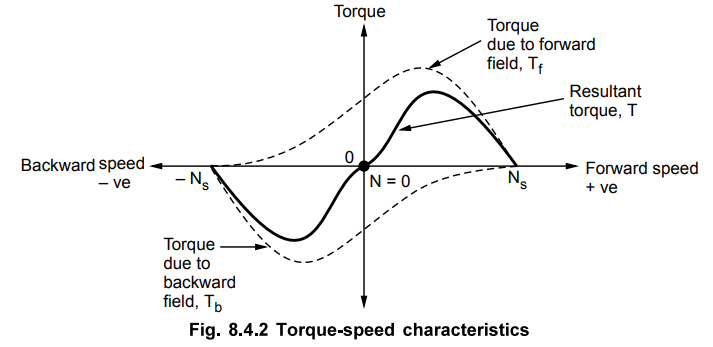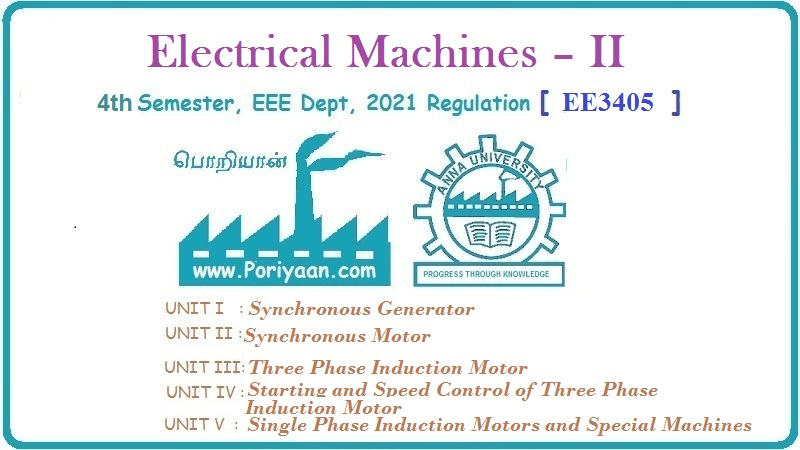Electrical Machines II: UNIT V: a. Single Phase Induction Motors
Double Revolving Field Theory
Single Phase Induction Motors
According to this theory, any alternating quantity can be resolved into two rotating components which rotate in opposite directions and each having magnitude as half of the maximum magnitude of the alternating quantity.
Double Revolving Field Theory AU
: May-12, 13, 17, Dec.-05, 12, 15, 16, 17
According
to this theory, any alternating quantity can be resolved into two
rotating components which rotate in opposite directions and each having
magnitude as half of the maximum magnitude of the alternating quantity.
In
case of single phase induction motors, the stator winding produces an
alternating magnetic field having maximum magnitude of ϕlm.
According
to double revolving field theory, consider the two components of the stator
flux, each having magnitude half of maximum magnitude of stator flux i.e. (ϕ1m
/ 2). Both these components are rotating in opposite directions at the
synchronous speed Ns which is dependent on frequency and
stator poles.
Let
ϕf is forward component rotating in anticlockwise direction while ϕh
the backward component rotating in clockwise direction. The resultant of these
two components at any instant gives the instantaneous value of the stator flux
at that instant. So resultant of these two is the original stator flux.
The
Fig. 8.4.1 shows the stator flux and its two components ϕf and ϕh.
At start both the components are shown opposite to each other in the Fig. 8.4.1
(a). Thus the resultant R = 0. This is nothing but the instantaneous value of
stator flux at start. After 90°, as shown in the Fig. 8.4.1 (b), the two
components are rotated in such a way that both are pointing in the same direction.
Hence the resultant ϕE is the algebraic sum of the magnitudes of the
two components. So ϕR = ϕ1m /2) + (ϕ1m /2) = ϕ1m.
This is nothing but the instantaneous value of the stator flux at 0 = 90° as
shown in the Fig. 8.4.1 (c). Thus continuous rotation of the two components
gives the original alternating stator flux.

Both
the components are rotating and hence get cut by the rotor conductors. Due to
cutting of flux, e.m.f. gets induced in rotor which circulates rotor current.
The rotor current produces rotor flux. This flux interacts with forward
component f to produce a torque in one particular direction say anticlockwise
direction. While rotor flux interacts with backward component ϕb to
produce a torque in the clockwise direction. So if anticlockwise torque is
positive then clockwise torque is negative.
At
start these two torques are equal in magnitude but opposite in direction. Each
torque tries to rotate the rotor in its own direction. Thus net torque
experienced by the rotor is zero at start. And hence the single phase
induction motors are not self starting.
1. Torque-Speed Characteristics
The
two oppositely directed torques and the resultant torque can be shown
effectively with the help of torque-speed characteristics. It is shown in the
Fig. 8.4.2.

It
can be seen that at start N = 0 and at that point resultant torque is zero. So
single phase motors are not self starting.
However
if the rotor is given an initial rotation in any direction, the resultant
average torque increases in the direction in which rotor is initially rotated.
And motor starts rotating in that direction. But in practice it is not possible
to give initial torque to rotor externally hence some modifications are done in
the construction of single phase induction motors to make them self starting.
Another
theory which can also be used to explain why single phase induction motor is
not self starting is cross-field theory.
Review Questions
1. Explain the double revolving field theory as applied to
single phase induction motor and show that single phase induction motor is not
self starting. AU : May-12, 13, 14, 17 Dec.-12, 15, 16, 17 Marks 8
2. Show that a single phase sinusoidal field can be replaced by
two fields rotating around the air gap in opposite directions; sketch the slip
torque curve due to each field. Prove that
the motor has no starting torque.
Electrical Machines II: UNIT V: a. Single Phase Induction Motors : Tag: Engineering Electrical Machines - II : Single Phase Induction Motors - Double Revolving Field Theory
Related Topics
Related Subjects
Electrical Machines II
EE3405 Machine 2 EM 2 4th Semester EEE Dept | 2021 Regulation | 4th Semester EEE Dept 2021 Regulation
